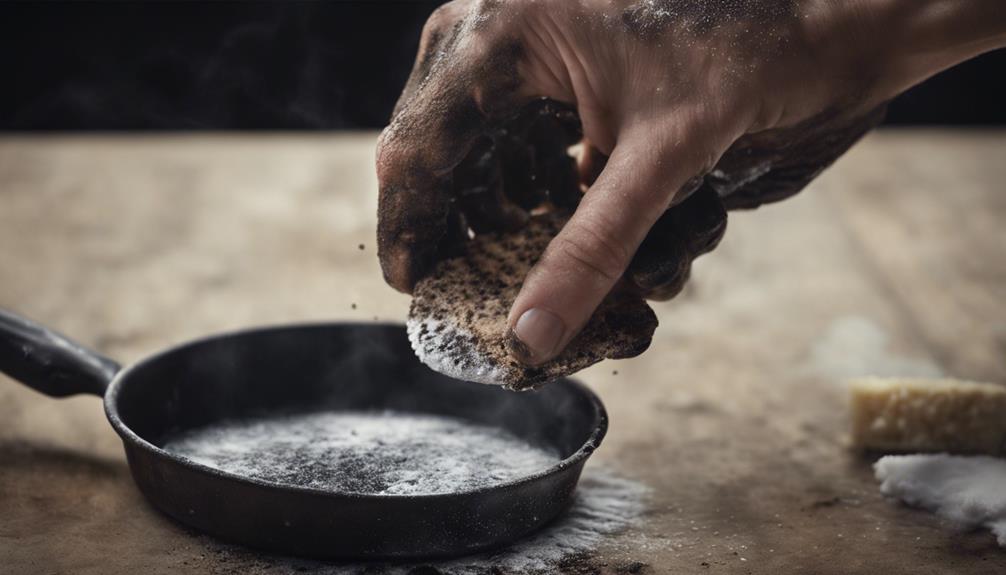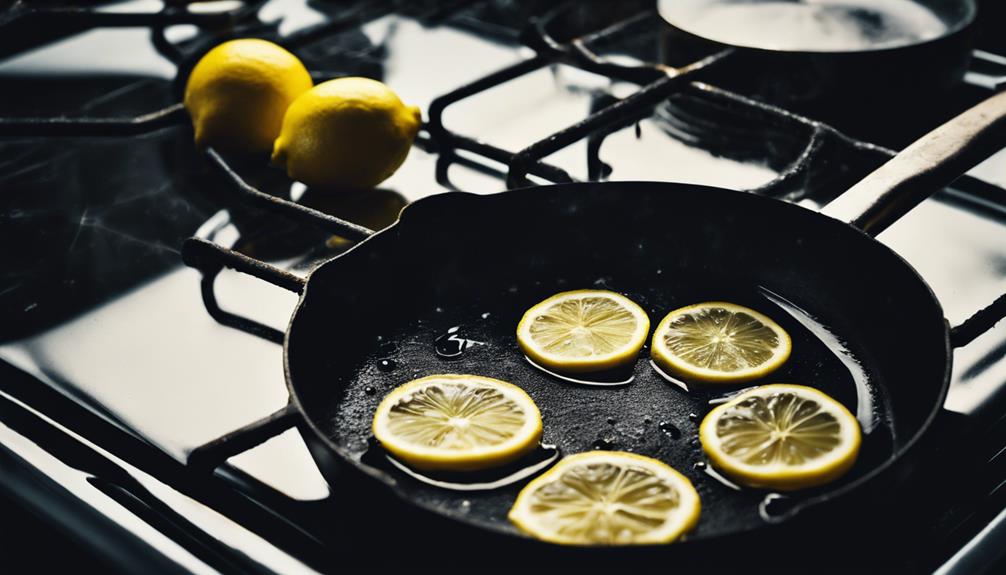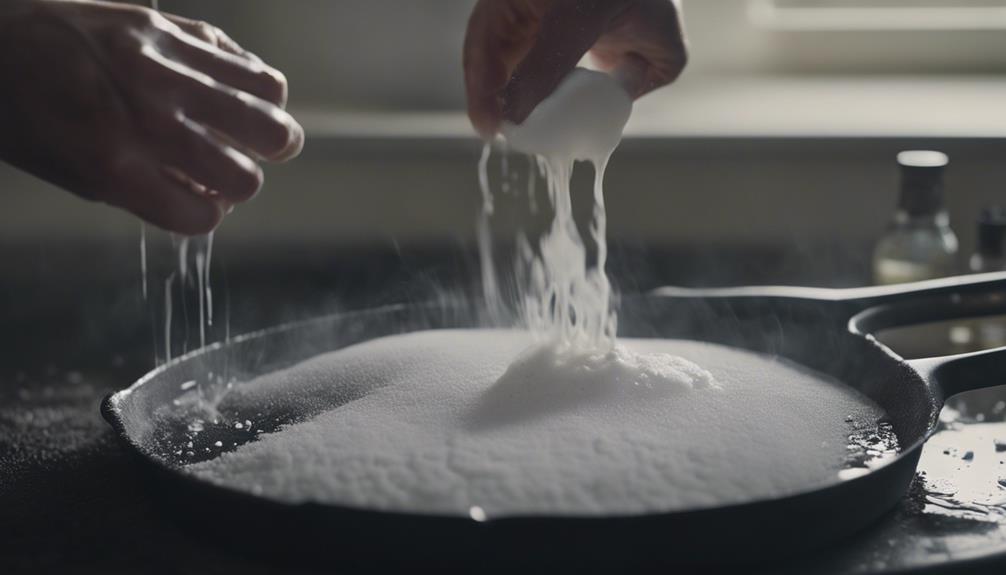Struggling to get burnt food out of your pan? Try soaking with vinegar or using a baking soda scrub. Make a paste with baking soda and water, scrub gently, then rinse. Soaking with vinegar for 30 minutes helps break down stuck-on food. Maintain lower heat while cooking to prevent burning. Need more tips for easier cleaning and to keep your cookware in top shape?
Benefits of Cleaning Burnt Pans
Keeping your pans clean offers numerous benefits, guaranteeing safe and enjoyable cooking experiences. Properly cleaning burnt pans is essential to prevent chemical transfer to your food during cooking, safeguarding your health.
Regularly caring for your pots and pans not only maintains food safety but also prevents health risks associated with leftover residue. Effective cleaning methods, such as using a mixture of water, baking soda, and vinegar to scrub and remove burnt food, help in avoiding burnt food and sticking.
By keeping your pans clean, you also ensure their longevity and appearance, leaving them looking brand new and pristine. Neglecting the cleaning of burnt pans can lead to a buildup of harmful substances that can affect the taste and quality of your dishes.
Therefore, investing time in cleaning your cookware properly is essential for a satisfying culinary experience.
Tools Needed for Cleaning
To effectively clean burnt food out of a pan, gather essential tools such as baking soda, white vinegar, dish soap, aluminum foil, and a scouring pad. These items will help you tackle tough stains and burnt-on residue efficiently. Here are some key tools you should have on hand:
- Cup of Baking Soda: A versatile cleaning agent that can help loosen burnt food particles.
- White Vinegar: Useful for breaking down tough stains and grease.
- Non-Scratch Sponge: Ideal for gentle scrubbing without scratching the pan's surface.
In addition to these basics, consider using Dishwashing gloves to protect your hands, especially when dealing with abrasive materials.
Bar Keepers Friend is a recommended cleaner known for its effectiveness against burnt-on food.
Swedish dishcloths can also be handy alternatives to sponges for cleaning burnt pans.
Having these tools ready will make the cleaning process more manageable and efficient.
Baking Soda Scrubbing Method

For the baking soda scrubbing method, start by creating a paste with baking soda and water to cover the burnt area on the pan. This technique leverages baking soda's mild abrasiveness to effectively loosen and remove burnt food.
Once the paste with baking soda is applied, use a scrub brush, nylon brush, or scouring pad to scrub the burnt area and lift off the residue. Boiling the baking soda paste in the pan can also assist in quickly cleaning off burnt-on food, particularly for stainless steel or aluminum pans.
Regularly employing the baking soda scrubbing method can help guarantee the prevention of the buildup of stubborn burnt-on residue in pots and pans. By incorporating this method into your cleaning routine, you can maintain your cookware in top condition and make sure that burnt food remnants are a problem of the past.
Vinegar Soaking Technique
Using a vinegar soaking technique is an effective method for removing stubborn burnt food residue from pans. The acidic properties of vinegar work wonders in breaking down burnt-on food without requiring harsh scrubbing. Here's why you should consider this natural method:
- Gentle Cleaning: Vinegar soaking provides a gentle approach to cleaning burnt pans, preserving their quality.
- Enhanced Cleaning Effectiveness: Allowing the pan to soak in a vinegar solution for at least 30 minutes greatly boosts the cleaning power, making it easier to remove stubborn residue.
- Minimal Effort Required: After the soaking time, the burnt food residue should wipe away effortlessly, minimizing the effort needed for a thorough clean-up.
Lemon Juice Cleaning Hack

You can effectively clean burnt food from your pan using lemon juice. This natural acid helps break down residue for easier scrubbing.
Discover how to make the most of this citrus cleaning hack.
Lemon Juice Effectiveness
The effectiveness of lemon juice in cleaning burnt food from pans is well-known among natural cleaning enthusiasts. When dealing with stubborn residue, lemon juice can be a game-changer due to its acidity and citric acid content.
Here's why lemon juice is a go-to cleaning hack for burnt pans:
- Acidity Action: The acidity in lemon juice helps to break down burnt-on food particles, making them easier to scrub away.
- Citric Power: The citric acid present in lemon juice works wonders in tackling those hard-to-remove burnt residues.
- Simple Solution: Boiling lemons in water and scrubbing with the citrus fruit is a straightforward and effective method for cleaning burnt pans.
Application Tips
To effectively apply the lemon juice cleaning hack for removing burnt food from pans, consider the following practical tips.
Lemon juice, with its acidic properties, is a natural cleaning solution for stubborn burnt spots. Start by squeezing fresh lemon juice onto the affected area and let it sit for a few minutes to break down the burnt-on food particles.
For more intense cleaning, try boiling lemons in water and using the resulting solution to soak the pan before scrubbing. This eco-friendly method is safe for use on stainless steel and other cookware.
After cleaning, the invigorating scent of lemon will linger in the pan, leaving it smelling fresh. Remember to rinse the pan thoroughly with water after cleaning to remove any remaining lemon residue.
Aluminum Foil Scrubbing Trick
Consider adding a touch of water and baking soda to your aluminum foil ball for enhanced scrubbing power when using the aluminum foil scrubbing trick to remove burnt food from your pan. This method is efficient and versatile, making it a go-to solution for tough burnt-on food on various cookware.
Here are some tips to maximize the effectiveness of the aluminum foil scrubbing trick:
- Wet the Foil: Before scrubbing, dampen the aluminum foil ball with water to create a gentle abrasive surface that won't damage your pans.
- Add Baking Soda: Sprinkle a bit of baking soda onto the foil ball to boost its cleaning power and help break down the burnt food residue.
- Scrub Gently: While the aluminum foil is tough on burnt food, remember to scrub gently to avoid scratching the surface of your pans.
Preventing Burnt Food Build-up

To prevent burnt food build-up in your pans, make sure to clean them thoroughly after each use, using gentle cleaners and soft sponges.
Additionally, adjusting the heat to a lower setting and closely monitoring the cooking time can help avoid scorching your food.
Cleaning After Each Use
After each use, make sure to clean your pan thoroughly with hot, soapy water to prevent burnt food build-up.
Here are some tips to keep your pans in top condition:
- Use a Gentle Touch: Opt for a non-abrasive sponge or cloth when cleaning your pan to avoid scratching its surface while effectively removing any food residue or stains.
- Don't Delay Cleaning: Avoid leaving leftover food or grease in your pan for an extended period, as they can lead to burnt-on food and make cleaning more challenging later on.
- Consistent Maintenance: Regularly cleaning your pan after each use not only prevents burnt food accumulation but also helps maintain the quality of your cookware. This simple habit can save you from the hassle of intense scrubbing in the future and ensure a pleasant cooking experience every time.
Using Low Heat
When cooking to prevent burnt food build-up, using low to medium heat is key to maintaining your pan's cleanliness and preventing stubborn residue. By adjusting the temperature setting to a lower range, you can avoid burning your food and reduce the chances of it sticking to the pan's surface.
Proper heat control plays an essential role in ensuring that your dishes cook evenly without scorching the pan. It's important to steer clear of high heat cooking, as this can lead to burnt food and make cleaning up a challenge.
Maintaining a lower heat while cooking promotes even cooking throughout your dish, helping you steer clear of burnt spots that are tough to remove later. By employing the right heat level, you can prevent food from sticking and burning, making your cleaning process much more manageable.
Monitoring Cooking Time
Properly monitoring the cooking time is essential for preventing burnt food build-up in your pans. Follow these key steps to make sure your food doesn't scorch or stick:
- Stay Focused: Avoid distractions while cooking to keep an eye on the clock and prevent burnt food. Engaging in other tasks can lead to overcooking and burnt dishes.
- Adjust Heat Accordingly: Be mindful of heat levels throughout the cooking process. Adjust the temperature as needed to prevent food from burning in the pan. Maintaining the right heat level is vital in avoiding burnt food build-up.
- Use Timers and Alarms: Employ cooking timers or set alarms to track cooking time accurately. These tools can help you stay on top of the cooking process timing and prevent burnt food disasters.
Set reminders to check on your food periodically and avoid any potential sticking or scorching issues. By monitoring cooking time diligently, you can guarantee a successful and delicious cooking experience while keeping burnt food at bay.
Conclusion
To sum up, cleaning burnt food out of a pan may seem like a tough nut to crack, but with the right techniques and a little elbow grease, you can easily restore your cookware to its former glory.
Remember, a stitch in time saves nine, so don't wait until the burnt food becomes a stubborn stain.
Follow these simple tips and your pans will be sparkling clean in no time!